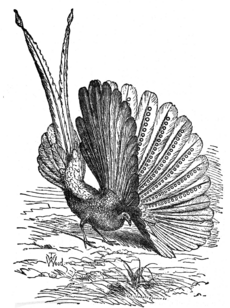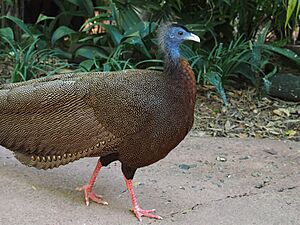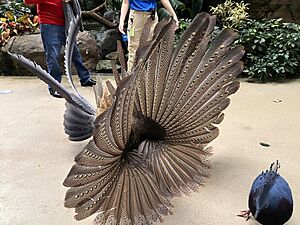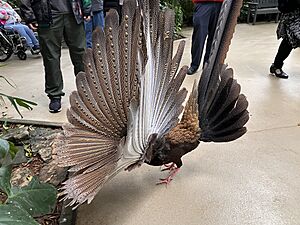Great argus facts for kids
Quick facts for kids Great argus |
|
|---|---|
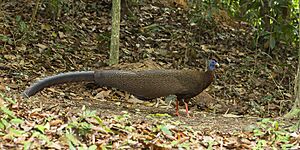 |
|
| Male | |
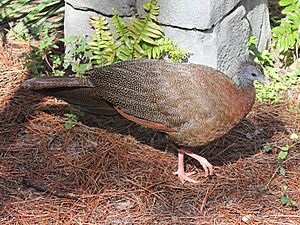 |
|
| Female | |
| Conservation status | |
| Scientific classification | |
| Genus: |
Argusianus
|
| Species: |
argus
|
| Synonyms | |
|
|
The great argus (Argusianus argus), also known as the greater argus, is a very large and beautiful pheasant bird. It lives in the jungles of Southeast Asia. This bird is famous for its amazing feathers and the special dance it does to attract a mate. It is not the same as the two types of crested argus birds.
Contents
What's in a Name?
The great argus got its name from Carl Linnaeus, a famous scientist. He named it after Argus Panoptes, a giant from Greek mythology. Argus had a hundred eyes! The bird's wings have many eye-like patterns, which reminded Linnaeus of this mythical giant.
There are two main types, or subspecies, of the great argus. One lives in the Malay Peninsula and Sumatra. The other, called A. a. grayi, lives in Borneo.
The Mystery of the Double-Banded Argus
For a long time, people wondered if there was another type of argus pheasant called the double-banded argus. This idea came from just one single feather found in London in 1871. It was thought to be from a bird in Java or Tioman Island.
However, scientists later decided that this feather likely came from a great argus with a unique, different feather. It was probably not from a whole new species. The feather was unusual, but it didn't mean a new type of bird existed. Today, the feather is kept at the Natural History Museum in London.
Other Names for the Great Argus
In the Malay language, the great argus is called Kuang raya. This name means "great pheasant."
What Does the Great Argus Look Like?
The great argus has brown feathers. Its head and neck are blue, and its upper chest is a reddish-brown color. It has black, hair-like feathers on top of its head and at the back of its neck. Its legs are red.
Male and Female Birds
The male great argus is one of the biggest pheasants. It can be about 160 to 200 centimeters (63 to 79 inches) long. This includes its very long tail, which can be 105 to 143 centimeters (41 to 56 inches) long! Males also have huge, wide wing feathers. These feathers are covered with many large "eyespot" patterns. Young males grow their full adult feathers when they are about three years old.
Female great argus birds are smaller and less colorful than the males. They have shorter tails and fewer eyespots. Females are usually 72 to 76 centimeters (28 to 30 inches) long, with a tail of 30 to 36 centimeters (12 to 14 inches).
How Does the Great Argus Live?
What Do They Eat?
Great argus birds look for food on the forest floor. They usually do this in the early morning and evening.
The Male's Mating Dance
When a male great argus wants to find a mate, he first clears a special open spot in the forest. This becomes his dancing ground. He makes loud calls to get the attention of females. Then, he performs an amazing dance! He spreads his wings out wide, turning them into two huge fans. These fans show off hundreds of "eyes" to the female. While he dances, his own eyes are hidden behind his fanned wings.
Reproduction and Breeding
Even though the male's dance might make you think they have many partners, the great argus is actually a monogamous bird. This means one male and one female stay together. The female usually lays only two eggs.
Where Do They Live?
The great argus lives in the jungles of Borneo, Sumatra, and the Malay Peninsula. These areas are all in southeast Asia.
Protecting the Great Argus
The great argus is considered a Vulnerable bird. This means its numbers are decreasing. This is happening because its jungle home is being destroyed, and in some areas, people hunt them. Because of this, the great argus is listed on Appendix II of CITES, which helps control trade in endangered animals.
Images for kids



